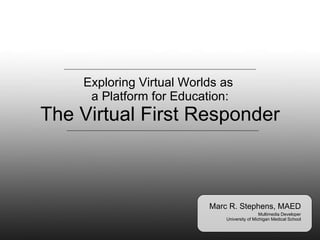Final SL For Ed VFR 03June2009
- 1. Exploring Virtual Worlds as a Platform for Education: The Virtual First Responder Marc R. Stephens, MAED Multimedia Developer University of Michigan Medical School
- 2. Why Virtual Reality for Education? Experiential Learning - Learn by doing Confucius said, ˇ° Tell me and I will forget. Show me and I may remember. Involve me and I will understand.ˇ± Sense of shared presence Lends realism to a learning scenario, a sense of ˇ®being thereˇŻ. Safe environment In VR simulation, potentially dangerous activities can be engaged in without fear of real harm. & letˇŻs face itˇ VR is fun! :)
- 3. The Elective Course 18 second-year medical students Focus Exploring the technology Application to education Topic for medical relevance Mass-casualty triage Data gathering Videotaped while interacting with systems Interviewed on camera Completed an impression survey
- 4. The Classroom Medical School Histology Lab Students used their own laptops Built-in ethernet connections Ceiling-mounted projector Seats about 30 people
- 5. Course layout 3 two-hour sessions Classroom Second Life Safari @ Wolverine Island Virtual First Responder @ Play2Train Field Trip Virtual First Responder @ The CAVE
- 6. Second Life Safari First session Intensive SL ˇ®bootcampˇŻ session Held on Wolverine Island Equipment shakedown SL basic skills Movement/navigation Communication Avatar customization Inventory management
- 7. Virtual First Responder @ Play2Train Second session Exploring use of SL in the context of conducting mass casualty triage training Play2Train disaster simulator Triage activity collaborative groups evaluate casualty mannequins Assign preliminary triage level Whole-class summary
- 8. Triage Mannequins ˇ® SculptyˇŻ object statues bought commercially Edited for project variety of postures textured and colored Click for diagnostic findings
- 9. Video Interlude Virtual First Responder @ Play2Train
- 10. Virtual First Responder @ The CAVE Third session Field trip to U of MˇŻs CAVE Introduction to the CAVE by facility director Triage presentation by Dr. Wilkerson CAVE triage experience
- 11. Video Interlude Virtual First Responder @ CAVE
- 12. Factors considered How should we introduce VR to this audience in a way that is relevant to them? Student knowledge level Computer savvy Medical training Medical relevance of content Hardware capabilities of student laptops Laptop and network concerns Technical savvy of our own staff SL Scripting and Building skills
- 13. Course Support Staff Marc Stephens co-course designer, instructional design, course facilitator Chris Chapman co-course designer, instructional design, and camerawork support Roger Burns laptop/hardware/network support Jason Engling in-world camerawork for Play2Train Patricia Anderson Second Life liaison, in-world instructional assistant Bill Wilkerson, MD triage presentation, consulting with course designers Staff of the CAVE facility at Duderstadt Center Staff of Play2Train in Second Life
- 14. Wish list for next timeˇ Distance learners Explore depth of presence Use of SLˇŻs voice capabilities Closer collaboration with relevant faculty More in depth medical relevance Possible course integration More advanced training equipment CPR dummies in the CAVE Advanced triage mannequins in SL Integrate more game-like elements Encourage student exploration of the environment
- 15. Questions & Answers Thanks for attending! Marc R. Stephens, MAED Memetic Projects @ SL [email_address] 734-763-0297















![Questions & Answers Thanks for attending! Marc R. Stephens, MAED Memetic Projects @ SL [email_address] 734-763-0297](https://image.slidesharecdn.com/finalslforedvfr03june2009-090602090716-phpapp01/85/Final-SL-For-Ed-VFR-03June2009-15-320.jpg)